Aspirin routes - Study guides, Class notes & Summaries
Looking for the best study guides, study notes and summaries about Aspirin routes? On this page you'll find 1509 study documents about Aspirin routes.
Page 4 out of 1.509 results
Sort by
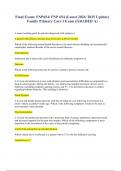
-
Final Exam: FNP654/ FNP 654 (Latest 2024/ 2025 Update) Family Primary Care I Exam (GRADED A).
- Exam (elaborations) • 19 pages • 2024
- Available in package deal
-
- $12.99
- + learn more
Final Exam: FNP654/ FNP 654 (Latest 2024/ 2025 Update) Family Primary Care I Exam (GRADED A). A major teaching point for patients diagnosed with epilepsy is A patient with absence seizures may never have a driver's license Which of the following mental health disorders is the most chronic disabling and economically catastrophic medical disorder of the severe mental illnesses Schizophrenia Inattention and a sleep-wake cycle disturbance are hallmark symptoms of Delirium Which of the follo...
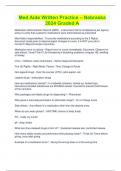
-
Med Aide Written Practice – Nebraska 2024 Graded A
- Exam (elaborations) • 13 pages • 2024
- Available in package deal
-
- $11.99
- + learn more
Medication Administration Record (MAR) - a document that is completed as per agency policy to verify that a patient's medications were administered as prescribed Med Aide's responsibilites - To provide medications according to the 5 Rights, document meds given & observe/report changes to nurse. It is NOT your job to monitor!!! (Beyond scope of practice) Medication error is noticed - Report error to nurse immediately. Document. Observe for side effects. Temp? Pain? Life-threatening if bre...
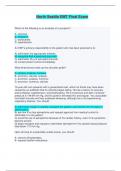
-
North Seattle EMT Final Exam - Questions and Answers (Complete Solutions)
- Exam (elaborations) • 36 pages • 2024
-
- $24.99
- + learn more
North Seattle EMT Final Exam - Questions and Answers (Complete Solutions) Which of the following is an example of a symptom? A. cyanosis B. headache C. tachycardia D. hypertension An EMT's primary responsibility to the patient who has been poisoned is to: A) administer the appropriate antidote. B) recognize that a poisoning occurred. C) administer 25 g of activated charcoal. D) contact poison control immediately What three bones make up the shoulder girdle? A. clavicle, scapula, humerus B. ac...

-
1 FUNDAMENTALS, NUR 100, EXAM 2 REVIEW QUESTIONS AND ANSWE| LATEST UPDATES/ COMPLETE EXAM PREDICTION PAPER |RS, RATED A+/ GRADED A+
- Exam (elaborations) • 5 pages • 2024
- Available in package deal
-
- $9.49
- + learn more
1 FUNDAMENTALS, NUR 100, EXAM 2 REVIEW QUESTIONS AND ANSWERS, RATED A+/ GRADED A+ The pt recently had a cast applied to his L lower leg after a football injury in which he broke his tibia. After the application of the cast, the nurse felt the toes of his left and right foot. To assess circulation in the L foot, the nurse should do which of the following? - -A. Expect that the temperature of the left foot to be the same as the right foot. A nurse uses four basic skills during a physical...
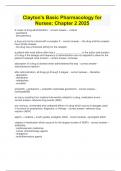
-
Clayton's Basic Pharmacology for Nurses: Chapter 2 2025
- Exam (elaborations) • 7 pages • 2024
-
- $10.49
- + learn more
3 routes of drug administration: - correct answer--- enteral - parenteral - percutaneous a drug only forms a bond with a receptor if: - correct answer--- the drug and the receptor have similar shapes - the drug has a chemical affinity for the receptor a patient with renal failure often has a ___________________ in the action and duration of a drug if the dosage and frequency of administration are not adjusted to allow for the patient's reduced renal function - correct answer--increas...
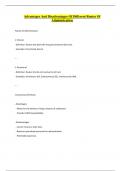
-
Advantages And Disadvantages Of Different Routes Of Administration
- Exam (elaborations) • 6 pages • 2024
- Available in package deal
-
- $10.19
- + learn more
Advantages And Disadvantages Of Different Routes Of Administration Routes of Administration 1. Enteral: - Definition: Routes that deal with the gastrointestinal (GI) tract. - Examples: Oral, Rectal, Buccal. --- 2. Parenteral: - Definition: Routes that do not involve the GI tract. - Examples: Intravenous (IV), Subcutaneous (SC), Intramuscular (IM). --- Intravenous (IV) Route - Advantages: - Allows for the delivery of large volumes of medication. - Provides 100% bioavaila...
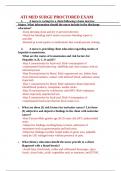
-
ATI MED SURGE PROCTORED EXAM
- Exam (elaborations) • 12 pages • 2024
- Available in package deal
-
- $17.99
- + learn more
ATI MED SURGE PROCTORED EXAM 1. A nurse is caring for a client following a bone marrow biopsy. What information should the nurse include in the discharge education? -Keep dressing clean and dry to prevent infection -Watch for bleeding and if notice excessive bleeding report to provider -Remind pt avoid aspirin or medications that would prevent clotting 2. A nurse is providing client education regarding modes of hepatitis transmission. What are the routes of transmission and risk factor...

-
CEN Exam- Cardiovascular Emergencies Questions And Answers
- Exam (elaborations) • 10 pages • 2024
- Available in package deal
-
- $10.49
- + learn more
CEN Exam- Cardiovascular Emergencies Questions And Answers Preload refers to: a. The volume of blood entering the left side of the heart b. The volume of blood entering the right side of the heart c. The pressure in the venous system that the heart must overcome to pump the blood d. The pressure in the arterial system that the heart must overcome to pump the blood - answerb. Preload is the volume of blood that enters the right side of the heart. This volume stretches the fibers in the he...
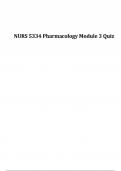
-
NURS 5334 Pharmacology Module 3 Quiz
- Exam (elaborations) • 20 pages • 2024
- Available in package deal
-
- $12.00
- + learn more
NURS 5334 Pharmacology Module 3 Quiz Time Course of Local Anesthesia ■ Onset of local anesthesia ■ The ability of an anesthetic to penetrate the axon membrane is determined by three properties: Before anesthesia can occur, the anesthetic must diffuse from its site of administration to its sites of action within the axon membrane. Anesthesia is delayed until this movement has occurred. The ability of an anesthetic to penetrate the axon membrane is determined by three properties: molecul...
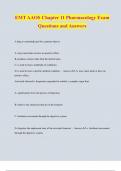
-
EMT AAOS Chapter 11 Pharmacology Exam Questions and Answers
- Exam (elaborations) • 13 pages • 2024
- Available in package deal
-
- $12.49
- + learn more
EMT AAOS Chapter 11 Pharmacology Exam Questions and Answers A drug is contraindicated for a patient when it: A. may cause harm or have no positive effect. B. produces actions other than the desired ones. C. is used to treat a multitude of conditions. D. is used to treat a specific medical condition. - Answer ️️ -A. may cause harm or have no positive effect. Activated charcoal is frequently suspended in sorbitol, a complex sugar that: A. significantly slows the process of digestion. ...

How much did you already spend on Stuvia? Imagine there are plenty more of you out there paying for study notes, but this time YOU are the seller. Ka-ching! Discover all about earning on Stuvia


